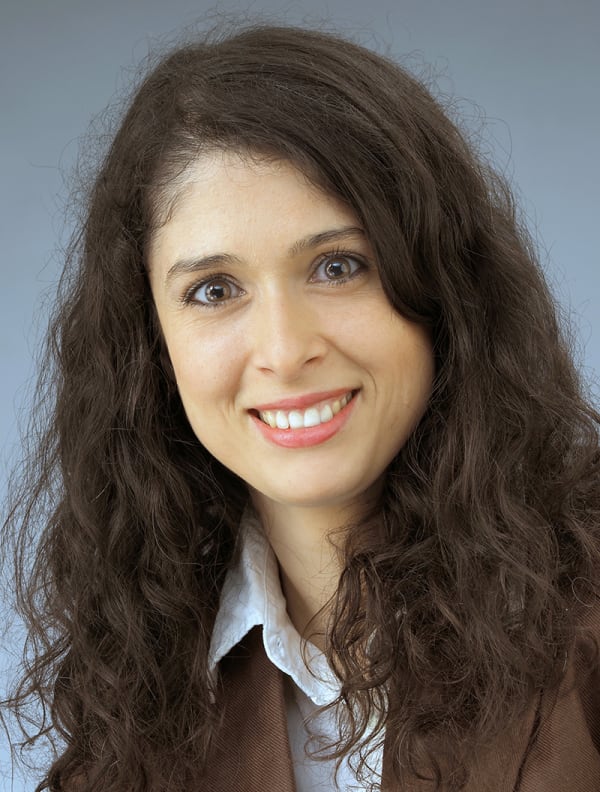As a child, Ana Luisa Coito wanted to be a teacher, like her mother. She was interested in science and health but didn’t want to be a doctor “because I couldn’t see blood.” Coito also liked math and physics, so she decided to pursue degrees in biomedical engineering at the University of Lisbon. She then moved to Geneva to earn a PhD in neuroscience, as well as a Certificate of Advanced Studies in nutrition in Zürich.
“Ana was recommended to the University of Geneva’s neuroscience program by Fernando Lopes da Silva, one of the most eminent figures in neurophysiology,” said Serge Vulliémoz, associate professor and neurologist at University Hospital and senior author of Coito’s award-winning paper. “While working toward her PhD, she did an amazing job of developing methods that had only limited application to epilepsy so far. We conducted several novel studies to show you can extract more information from an EEG than we currently do—you can look at network aspects of brain disorders and how different areas exchange information.”
The group’s initial studies were done with high-density EEG, which can involve up to 256 electrodes. These studies during her PhD showed new dynamic patterns of brain network changes during interictal epileptic activity but also patient specific alterations during periods without visible EEG abnormalities.
Finding more information in EEG readings
Coito was then interested in applying these information extraction methods—a combination of electrical source imaging (ESI) and direct functional connectivity (DFC)—to low-density EEG recordings, which are much more widely available worldwide. She wanted to know if these techniques could help to identify the epileptogenic zone in people with focal epilepsy. Identifying the source of focal seizures is the first step toward epilepsy surgery, which in many cases can eliminate seizures altogether.
To complete her research, Coito worked at a large regional hospital in Aarau, not far from Zürich; the hospital completed a high number of clinical EEG recordings but did not have a research team. Keeping a post-doctoral academic position in Geneva, she pooled EEG data from both centers.
The experience was challenging but enriching. “It was important for me to keep online contact with my colleagues in Geneva while working with the clinicians in Aarau,” who were very welcoming, said Coito.
The study included 34 patients with focal epilepsy; all had a previously well-characterized epileptogenic zone. The combination of ESI and DFC reliably corroborated the epileptogenic zone in 90% of patients with temporal lobe epilepsy, and 57% of those with extratemporal lobe epilepsy.
Techniques add diagnostic value
Coito was gratified to see that the methods she had worked on while earning her PhD were applicable to a clinical setting. “We showed that these techniques are feasible using low-density EEG,” she said. “If we can refine this, it could help many more patients worldwide. Especially for complicated cases, this could add diagnostic value.”
Though the technique isn’t quite ready for clinical use, Coito’s work has moved the research forward. “This was a translational approach—bringing these methods to patients to learn something about the disease,” said Vulliémoz. “This will help the epilepsy community see that you can get extra information from an EEG.”
Coito is currently on maternity leave; the journal prize has boosted her motivation to continue her research. She’s inspired to seek a position that combines her interests in neuroscience and nutrition.
“Ideally, I would study the impact of certain nutritional choices on our brain, or the relationship between the gut and the brain, and their interactions with epilepsy and medication,” she said. “And I’m still interested in teaching.”
About the ILAE Journal Prizes
Each year, the ILAE awards one Basic Science and one Clinical Science Prize to the first authors of original research articles published in Epilepsia Open during the preceding year. Awardees are nominated and selected by the journal’s editorial board, the editors-in-chief, and the ILAE president.
The prize is intended to stimulate excellence in epilepsy research and reward young researchers for outstanding contributions to the field.
Watch the 2020 Journal Prize Symposium on YouTube, including a talk by Dr. Coito about her research.
##
Founded in 1909, the International League Against Epilepsy (ILAE) is a global organization with more than 120 national chapters.
Through promoting research, education and training to improve the diagnosis, treatment and prevention of the disease, ILAE is working toward a world where no person’s life is limited by epilepsy.
To learn more, visit our website (available in multiple languages) or find us on Facebook.
We’re also on Twitter in English, French, Japanese, Portuguese and Spanish.
Original post https://alertarticles.info


